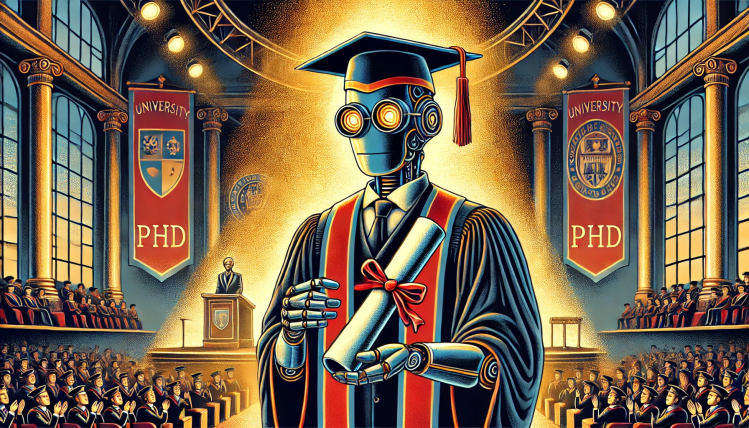Forget GPT-5! OpenAI Launches New AI Model Family o1 Claiming PhD-Level Performance
OpenAI has been at the forefront of artificial intelligence, consistently pushing boundaries with its AI models. While many were eagerly anticipating GPT-5, OpenAI surprised the tech world by introducing a new AI model family: GPT-o1. This model family claims to deliver PhD-level performance, marking a significant leap forward in natural language processing. In this blog, we’ll explore the capabilities of GPT-o1, how it compares to GPT-4o vs GPT-5, and what this means for AI development, including OpenAI’s efforts to offer greater AI model customization.
What Is the GPT-o1 Model?
The GPT-o1 model is the latest addition to OpenAI’s portfolio of AI large language models. While GPT-5 has been delayed, GPT-o1 has taken center stage with its advanced capabilities. This model family is designed to perform complex tasks with PhD-level performance in specific areas, such as research, reasoning, and decision-making.
Key Features of the GPT-o1 Model
- Improved Reasoning Capabilities: One of the standout features of GPT-o1 is its enhanced ability to understand and process complex reasoning tasks. OpenAI has focused on making this model much more effective in domains where higher-level intelligence is required.
- Advanced Context Windows: With a larger context window, the GPT-o1 model can process more tokens at once, allowing it to better handle long, intricate inputs. This increases the accuracy of its outputs, especially when managing detailed requests.
- Task-Specific Mastery: By claiming PhD-level performance, OpenAI suggests that GPT-o1 excels in specific tasks that require specialized knowledge, making it a valuable tool for academic, legal, and technical research(OnGraph).
GPT-4o vs GPT-5: What Sets Them Apart?
While GPT-5 has been pushed back to a late 2025 release date, the debate around GPT-4o vs GPT-5 remains at the forefront of AI discussions. GPT-4o, another recently launched model by OpenAI, offers substantial improvements over its predecessor but still falls short of the expectations set for GPT-5.
How GPT-4o Compares to GPT-5
- Reasoning and Context Windows: GPT-4o improved significantly on reasoning abilities, and its context window allows for more tokens to be processed, enhancing the overall interaction experience. However, GPT-5 promises even better reasoning capabilities with larger training data, making it more powerful in terms of understanding and processing highly complex queries.
- Training Data and Parameters: GPT-5 is expected to be trained on more data than GPT-4o, with estimates suggesting it could handle up to 2 trillion parameters(OnGraph). This will allow GPT-5 to outperform GPT-4o by a significant margin, particularly in terms of learning from data and generating more accurate results.
AI Model Customization: A Game Changer
OpenAI’s recent focus on AI model customization is another exciting development. With the rise of models like GPT-o1, users can now customize their AI to suit specific tasks, making it more versatile and user-friendly. This is particularly important for businesses, researchers, and developers who need tailored AI solutions for different sectors.
Benefits of AI Model Customization:
- Personalized Solutions: With customization, businesses can now tweak the AI to better fit their needs, whether they’re using it for customer service, legal research, or creative content generation.
- Efficiency and Accuracy: By optimizing AI models for specific tasks, users can increase the accuracy of the model’s outputs and reduce errors in complex tasks.
- Scalability: OpenAI’s new customization capabilities make it easier for companies of all sizes to integrate AI into their operations without needing large-scale development teams(OnGraph).
OpenAI Model Family: Expanding the Horizons of AI
The OpenAI model family now includes a wide array of AI models, each designed for specific tasks and use cases. While many were focused on the potential of GPT-5, the release of GPT-o1 marks a strategic shift for OpenAI, showing that the company is not just chasing bigger, more powerful models but also developing task-specific intelligence.
Why GPT-o1 Stands Out
- Task-Specific PhD-Level Performance: As noted, GPT-o1 claims to have PhD-level performance, meaning it can perform exceptionally well in niche areas such as scientific research or legal document analysis.
- AI Integration and Expansion: This model family allows users to integrate AI across different sectors, offering greater flexibility than previous models. Whether for academic research or creative industries, GPT-o1 adapts to fit diverse needs(FUTURES – ON AI)(OnGraph).
The Future of GPT-5: What to Expect
Though the focus is currently on GPT-o1, many are still eagerly awaiting the release of GPT-5, which has been delayed until 2025. GPT-5 is expected to offer not only increased reasoning capabilities but also far larger training data, improved context windows, and more parameters than any previous model.
Key Features Expected in GPT-5:
- Enhanced Reasoning and Decision-Making: GPT-5 will likely bring even more advanced reasoning and decision-making capabilities, making it a powerful tool for industries that require strategic planning and problem-solving.
- Larger Context Window: Building on the success of GPT-4o and GPT-o1, GPT-5 is expected to handle larger chunks of information, offering even greater accuracy in long conversations or detailed document reviews.
- Increased Parameters: With an expected 2-5 trillion parameters, GPT-5 will be one of the most powerful AI models ever created, capable of managing highly complex data and queries(OnGraph).
AI Large Language Models: OpenAI’s Dominance
OpenAI’s dominance in the field of AI large language models is evident with its rapid release of models like GPT-4o and GPT-o1, both of which are precursors to the highly anticipated GPT-5. These models set a new standard for the industry, pushing the boundaries of what AI can achieve in terms of reasoning, context understanding, and customization.
How Large Language Models Are Shaping AI:
- Natural Language Processing (NLP): With more advanced models, NLP capabilities have expanded, allowing for more human-like conversations and interactions. This is crucial for businesses that use AI in customer support, marketing, and communications.
- Research and Development: AI large language models like GPT-o1 and GPT-5 provide unparalleled insights for researchers, enabling faster, more accurate analysis of vast datasets(OnGraph).
OpenAI’s AI Model Family Sets New Standards
OpenAI continues to redefine the landscape of artificial intelligence with its AI model family. While the world eagerly waits for GPT-5, the release of GPT-o1 demonstrates that OpenAI is focused on delivering high-performance, customizable AI solutions that can achieve PhD-level performance in specialized tasks. As AI models like GPT-4o and GPT-o1 continue to evolve, it’s clear that OpenAI’s innovations will shape the future of artificial intelligence.
To learn more about AI development and how it can benefit various industries, visit Regent Studies for in-depth resources and guides.



